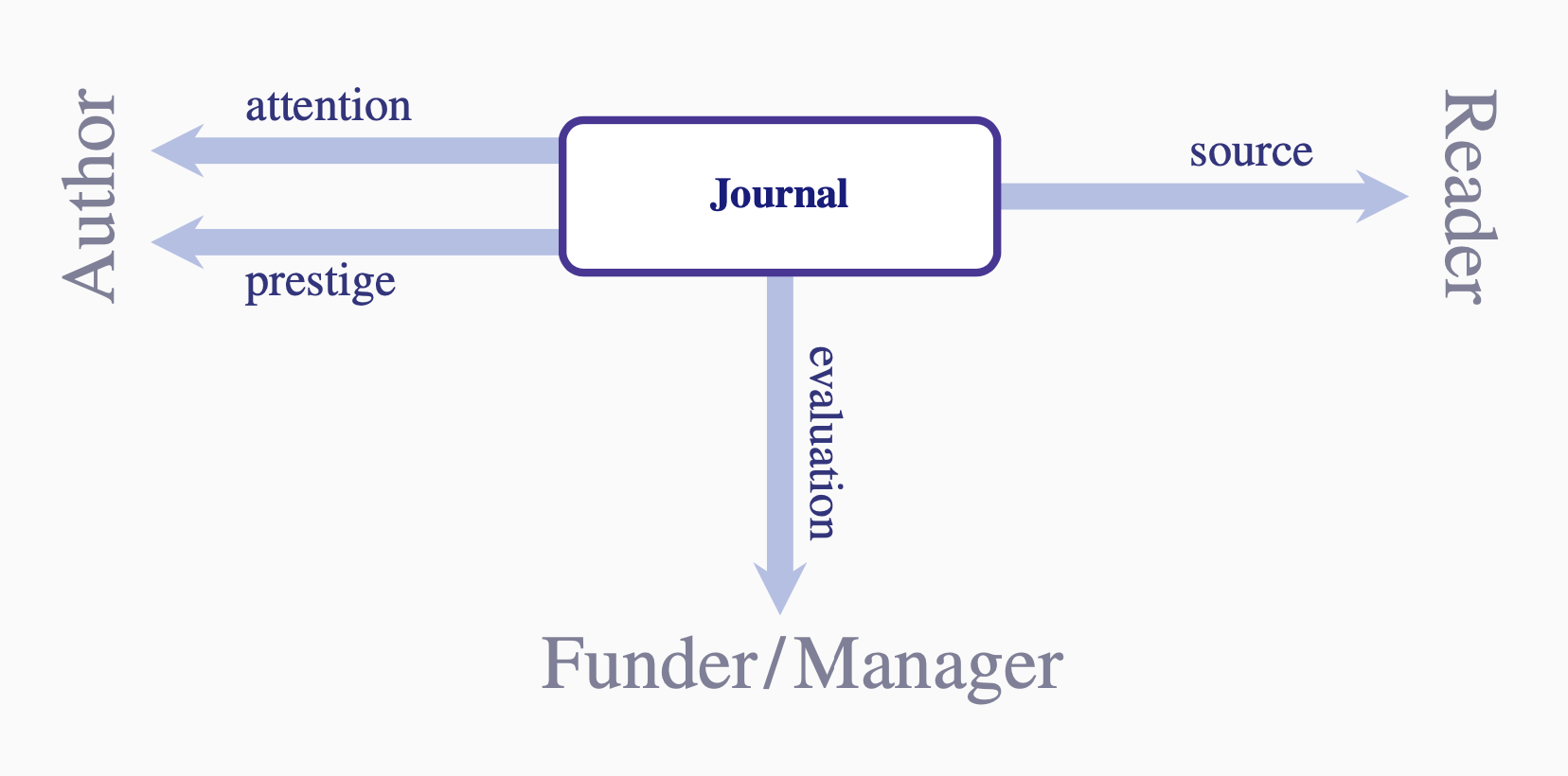Background: The Journal
Sometimes it is easy to lose sight of still-essential aspects of the scholarly journal, especially when contemplating radical reforms of the system. Aiming to foster a more well-rounded picture, we review here a few aspects of the journal, its roles and context.
Functional View
Legacy functions
- dissemination;
- registration (= recording who discovered first);
- archiving (= establishing the version of record).
These functions were quite central in the past to the purpose of the journal; nowadays, they can also be easily achieved through other means.
Auxiliary functions
- preparation (= revision after reviews, then copyediting/typesetting);
- definition (= outlining a subfield and a community around it).
These two functions are still quite important (indeed, the process of revising upon feedback from reviewers could be seen as a continuation, sometimes even a proper part, of the research itself), but they could (at least conceivably) be served through mechanisms other than the journal.
Core functions
- validation (= the result is sound);
- filtration (= helps select what’s worth reading to whom);
- signaling (= helps select who’s worth promoting or funding).
To our mind, it’s these three functions, knotted in a single social institution, that make the journal still indispensable today.
Transactional View
Predictive channel
- The author gets attention: the work is seen by the right audience of peers;
- The reader gets sources: she receives selected and sound results on which to build research.
The journal mediates bringing articles to readers, stamped by a statistical measure (the journal’s profile and renown, built mostly as an average of past articles) that they’re worth spending the time to read. That this measure is imperfect does not make it useless, and is better than other shortcuts readers might take to protect their time.
Evaluative channel
- The author gets prestige, as the journal’s renown reflects on the author.
- The funder/manager gets evaluations: a measurement of an author’s work, again through the renown of the journal.
The predictive and evaluative sides could in principle be decoupled (e.g., performed by different services). Indeed, DORA (= the San Francisco Declaration on Research Assessment, 2012) calls for evaluation of research to be done independent of the Journal Impact Factor (a skewed numeric replacement for the journal’s profile), and further, independent of an article’s journal venue altogether. However, this leaves untouched the need for the predictive side (used for filtering before any thorough reading).
 ¶
¶
An economics view would be to model each journal as a multi-sided market (a platform). Worth noticing are the readers’ seeking costs (the effort and time spent finding an article that would reward close reading), and that a subscription does not purchase articles as such, but an option value (the availability of a stream of articles, on the probability of needing one of them in the future).
Scholarly communication is built on small networks: each author is connecting with relatively few readers. (Comparisons with iTunes, television, or other media at mass-market scales may be tempting, but are flawed.)
Formatting
Formatting is a key function of scholarly communication, as the presentation and layout of articles assists both filtering and assimilation. The patterns and conventions of the field (e.g., definition–theorem–proof; in general, the typical structure of an article) offer guidance and can accelerate the reader; poor writing or typography poses obstacles. (The sensitivity to these obstacles seems to differ greatly among readers.)
The surprising survival of PDF as the format of choice (across all scholarly publishing) hints that the layout traditions from the age of print still remain the most comfortable, readable or understandable, and again, that formatting is important.
A Rising Pressure
Across all scholarly fields, various growth figures are reported: the number of journals is increasing at ~3% per year; the number of researchers, at ~4%; the amount spent on R&D, at ~3% (on top of inflation); the number of citeable items, at ~8% (doubles every nine years). The exact numbers matter less than the trend and the pressure added: It becomes harder to find what you need to read; it becomes harder to evaluate someone’s research output. An increasing abundance of content leads to an increasing scarcity of researchers’ time and attention.
This makes the core functions of the journal more, not less, necessary. The concomitant need for more fine-grained filtering, rather than allow that journals become superfluous (in favor of, for example, more amorphous publication on preprint servers or after soundness-only review), instead leads to further increases in the number and granularity of journals, at least for the near future.
To our minds, the importance of the scholarly journal could diminish if its roles were to be supplanted, for example by large data-driven smart services, providing finer classification and matching. However, such services would most likely become both indispensable and expensive, and might well end up holding controlling power over scholarly communication and careers, more than traditional publishing ever did. Fostering a healthy and vibrant ecology of scholar-led journals might provide a counterbalance and should be preferable.
Posted in May 2019
Social Institution
The journal is an established social institution, and while it settled in its current form in the age of print, the community’s habit of participating in the commons of scholarly knowledge, as editors and reviewers, has survived. For example, reviewers are not directly paid in part because reviewing is understood as part of being a scholar and helping the scholarly community.
Such shared understandings are easier to destroy than launch or replace. (The lack of success with post-publication peer-review models — e.g., forum-like comments on published materials, with continual updates, corrections, evaluations — is one example of a nice theory not moving much of the practice.) Imagined changes in collective action are painless to postulate, but hard to establish as functioning institutions. If you merely build it, often nobody will come.